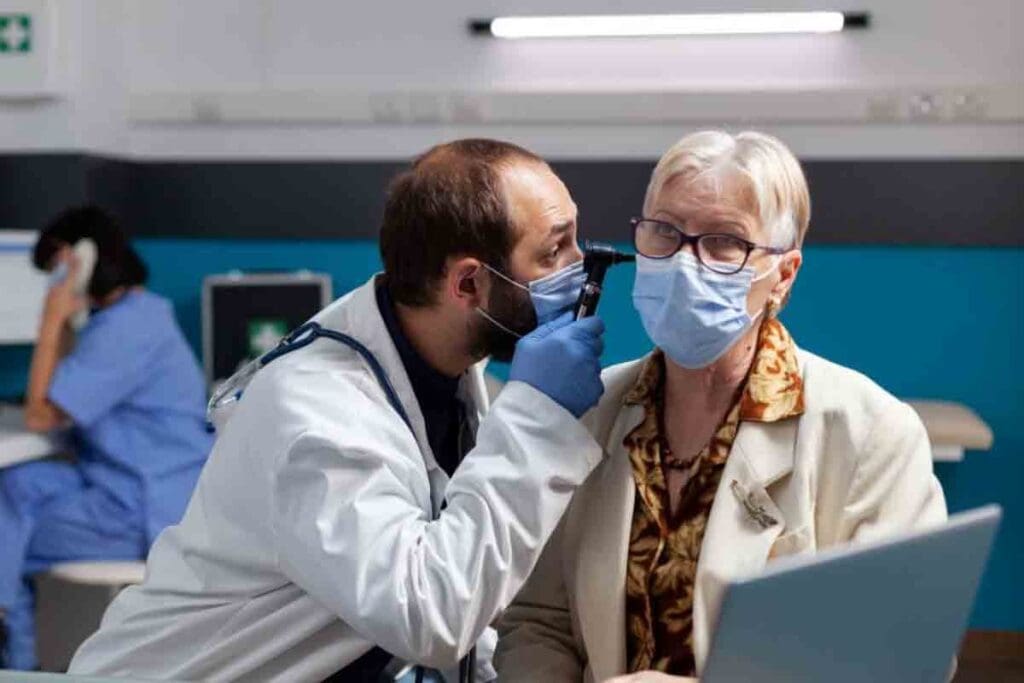Last Updated on November 20, 2025 by Ugurkan Demir

Iron deficiency happens when your body doesn’t have enough iron. This is needed to make healthy red cells. We’ll look at the signs and symptoms that might show you have an iron deficiency. Learn to interpret anemia blood sample results to detect early signs of iron deficiency.
At Liv Hospital, we focus on patient care. We aim to give you clear answers and top-notch medical advice. If you feel tired, weak, or have trouble breathing, it’s important to find out why. Our team is here to offer world-class healthcare and support.

It’s essential to be aware of iron deficiency and its impact on our health. Iron deficiency happens when our body doesn’t have enough iron to make hemoglobin. Hemoglobin is a key part of red blood cells.
Iron deficiency means our body’s iron stores are low. This leads to less hemoglobin being made. Without enough hemoglobin, we can get anemia, which makes us feel tired, weak, and short of breath. Iron deficiency is the most common nutritional disorder worldwide, affecting people of all ages and backgrounds.
Iron is key to making hemoglobin, which carries oxygen. Without enough iron, we can’t make enough hemoglobin, causing anemia. Iron also helps with energy and keeping our immune system strong.
The effects of iron deficiency go beyond just physical health. It can also affect our mental well-being. Signs include feeling tired, weak, having pale skin, shortness of breath, and brittle nails.
| Signs and Symptoms | Description |
| Fatigue and Weakness | Lack of energy and strength makes daily activities challenging. |
| Pale Skin | Reduced hemoglobin levels can cause the skin to appear pale or washed out. |
| Shortness of Breath | Insufficient oxygen delivery to tissues and organs. |
| Brittle Nails | Nails become fragile and break easily due to a lack of iron. |
Knowing about iron’s importance and recognizing deficiency signs can help us get early treatment. This improves our overall health.

It’s important to know the signs of iron deficiency early. Iron helps our bodies work right, and not having enough can cause many symptoms.
Iron deficiency shows up in many ways. Here are some common signs:
These symptoms can really affect your life. For example, pale skin is a clear sign because iron helps make hemoglobin, which is red.
Iron deficiency can also change how you act and think. Some signs include:
These changes might start small but can get worse. It’s key to watch for them, as women often see these symptoms more because of menstruation.
| Symptom Category | Common Symptoms |
| Physical Symptoms | Extreme tiredness, pale skin, shortness of breath, cold hands and feet, brittle nails |
| Behavioral and Cognitive Changes | Difficulty concentrating, memory issues, mood swings, decreased cognitive performance |
Iron deficiency often shows up as fatigue and weakness. These symptoms are common and really affect our daily lives. Iron is key for carrying oxygen to our cells, which is vital for energy.
Without enough iron, our bodies can’t make enough hemoglobin. Hemoglobin is a protein in red blood cells that carries oxygen. Without enough oxygen, our tissues and organs can’t work right, making us feel tired and weak.
This problem is not just about feeling tired. It can also affect our mental sharpness and how well we live our lives.
Key factors contributing to fatigue in iron deficiency include:
Fatigue from iron deficiency is different from other kinds. It doesn’t go away with rest, unlike fatigue from not sleeping enough. It can also come with other signs like pale skin, shortness of breath, and dizziness.
To figure out if your tiredness is from iron deficiency, watch for these signs:
Knowing why you’re tired is key to getting better. If iron deficiency is the problem, treatment can be as simple as changes in diet or iron supplements. It depends on how bad the deficiency is.
Iron deficiency is more than just feeling tired. It can also cause noticeable physical changes. These changes can be quite striking and often prompt individuals to seek medical attention. We will explore the common visible signs that indicate low iron levels.
One of the most common visible signs of iron deficiency is pale skin. It’s often accompanied by pale mucous membranes. This happens because iron is key to making hemoglobin, which gives blood its red color.
When iron levels are low, the skin can look pale or washed out. According to a medical organization, pale skin is a significant indicator of iron deficiency anemia.
Iron deficiency can also affect your nails and hair. Brittle nails that crack or break easily can be a sign of low iron levels. Hair loss or thinning hair can also occur due to an iron deficiency.
These symptoms happen because the body prioritizes iron distribution. It often does this at the expense of less critical functions like nail and hair growth.
Beyond pale skin, brittle nails, and hair loss, there are other physical signs. These include:
Recognizing these visible physical changes is key to identifying iron deficiency early. If you’re experiencing several of these symptoms, it’s essential to consult with a healthcare provider for proper diagnosis and treatment.
Women face unique challenges when it comes to iron deficiency. Factors like menstrual blood loss and pregnancy play a big role. Women with heavy periods are more likely to lose iron.
Menstruation is a big reason for iron loss in women. Each month, blood loss takes away iron, making women need more from their diet. Women with heavy periods are at a higher risk of iron deficiency.
Key factors to consider include:
Pregnancy raises iron needs due to increased blood volume and the fetus’s needs. Pregnant women need to eat more iron-rich foods or take supplements to avoid iron deficiency.
It’s important for pregnant women to:
Iron deficiency symptoms can vary in women compared to men. Women often feel tired, weak, and short of breath. These symptoms can be similar to other health issues.
Spotting these symptoms early can help get the right treatment.
| Symptom | Common in Women | Possible Misdiagnosis |
| Fatigue | Yes | Chronic Fatigue Syndrome |
| Weakness | Yes | Hypothyroidism |
| Shortness of Breath | Yes | Asthma or Heart Conditions |
Iron deficiency is more than just feeling tired. It affects many parts of our body. Low iron can cause serious health problems beyond just feeling exhausted.
Iron deficiency can mess with our blood and how oxygen gets to our brain. This can cause headaches and dizziness. When we don’t have enough iron, our bodies can’t carry enough oxygen, leading to these symptoms.
Studies show that people with iron deficiency anemia often get headaches and feel dizzy. This is because their brain and other tissues don’t get enough oxygen.
Iron deficiency can also make us feel cold, even when it’s not that chilly outside. This is called cold intolerance. Iron helps make thyroid hormones, which control our body temperature and metabolism.
Iron deficiency can also affect our brain and mood. Iron helps make important brain chemicals and keeps our neurons healthy. Without enough iron, we might struggle with focus, memory, and even feel depressed.
| Symptom | Description | Possible Cause |
| Headaches | Frequent or severe headaches | Reduced oxygen delivery to the brain |
| Dizziness | Feeling lightheaded or unsteady | Poor oxygenation of tissues |
| Cold Intolerance | Feeling cold in mild temperatures | Impaired thyroid hormone production |
| Cognitive Impacts | Difficulty concentrating, memory issues | Low iron affecting neurotransmitter synthesis |
It’s important to know about these effects of iron deficiency. If you’re feeling any of these symptoms, see a doctor. They can help figure out why and how to fix it.
It’s important to know why iron deficiency happens. Iron is key to making hemoglobin, which carries oxygen in our blood. Without enough iron, our bodies can’t function well.
Not getting enough iron from food is a big reason for iron deficiency. Foods high in iron include red meat, fish, beans, and cereals. People who eat mostly plants are at higher risk because plant iron is harder to use by the body.
Blood loss is another major cause. This can happen from injuries, surgeries, or ongoing issues like heavy periods or ulcers. Losing blood slowly over time can lead to iron deficiency.
Sometimes, our bodies need more iron. For example, pregnancy and adolescence are times when we need more iron. This is because our bodies are growing and changing.
Some people have trouble absorbing iron from food. This can be due to diseases like celiac disease or surgeries. Drinking coffee or tea with meals can also make it harder to absorb iron.
In summary, iron deficiency can come from not eating enough iron, losing blood, needing more iron, or having trouble absorbing it. Knowing these reasons helps us prevent and treat iron deficiency.
To find out if someone has iron deficiency anemia, doctors look at a blood sample. They check different parts of the blood. This helps them figure out if someone has anemia and how bad it is.
A Complete Blood Count (CBC) is a key test for anemia. It shows details about blood cells, like red and white blood cells, and platelets. For iron deficiency anemia, it looks at hemoglobin and hematocrit levels.
The CBC tells doctors if someone has anemia and what kind. A low mean corpuscular volume (MCV) means microcytic anemia. This is often due to iron deficiency.
Iron studies are also important for diagnosing iron deficiency anemia. These tests check iron levels in the blood, like serum ferritin, serum iron, and total iron-binding capacity (TIBC). Serum ferritin shows how much iron the body has.
Low serum ferritin means the body has less iron. High TIBC levels show the body is trying to get more iron. This is common in iron deficiency anemia.
Doctors also do other tests to check for other anemia causes or to see how well the patient is. These include tests for vitamin B12 and folate deficiency. These can also cause anemia.
By looking at all these test results, doctors can accurately diagnose iron deficiency anemia. Then, they can plan the right treatment.
Laboratory tests are key in spotting iron deficiency anemia and finding its causes. These tests help doctors figure out how severe it is and what treatment is needed.
Hemoglobin and hematocrit levels are important for diagnosing iron deficiency anemia. Hemoglobin is a protein in red blood cells that carries oxygen. Hematocrit is the part of blood made up of red blood cells. In iron deficiency anemia, both are usually low.
A study by a Medical organization shows that low hemoglobin and hematocrit are signs of iron deficiency anemia. For men, hemoglobin should be between 13.8 and 17.2 grams per deciliter. For women, it should be between 12.1 and 15.1 grams per deciliter. Hematocrit values for men should be between 40.7% and 50.3%, and for women, between 36.1% and 48.3%.
The Mean Corpuscular Volume (MCV) shows the average size of red blood cells. In iron deficiency anemia, the MCV is often low. This means the red blood cells are smaller than usual (microcytic anemia).
Serum ferritin shows how much iron is stored in the body. Low levels mean iron deficiency. Iron saturation shows how much iron is bound to transferrin. Both are usually low in iron deficiency anemia.
The Total Iron-Binding Capacity (TIBC) measures how much iron can bind to proteins like transferrin. In iron deficiency anemia, TIBC is often high. This is because there’s less iron in the blood.
Here’s a table summarizing the key lab findings:
| Laboratory Test | Normal Range | Iron Deficiency Anemia |
| Hemoglobin | 13.8-17.2 g/dL (men), 12.1-15.1 g/dL (women) | Low |
| Hematocrit | 40.7%-50.3% (men), 36.1%-48.3% (women) | Low |
| MCV | 80-100 fL | Reduced (Microcytic) |
| Serum Ferritin | 20-250 ng/mL | Low |
| Iron Saturation | 20%-50% | Low |
| TIBC | 240-450 mcg/dL | Elevated |
Understanding these lab findings is key for diagnosing and treating iron deficiency anemia. By looking at these indicators, doctors can create effective treatment plans.
We can spot low iron levels early by knowing the signs and tests. Catching it early is key. It helps stop iron deficiency anemia from getting worse.
Serum ferritin shows if you have enough iron. The a Medical organization says it’s a good sign of iron levels. Low ferritin means you’re running low on iron, even before other tests show it.
Ferritin testing is great because it finds iron problems early. It catches issues before your blood counts drop. This makes it a key part of managing iron levels.
Before anemia shows up, there are small signs of low iron. These include feeling tired, weak, and other vague symptoms. Spotting these signs early can lead to checking your iron levels.
Other small signs might be cognitive and physical changes. These could be trouble focusing, memory problems, or feeling less energetic. These symptoms can have many causes. So, it’s important to think about iron deficiency too.
It’s important to check iron levels regularly, through ferritin tests. This is true for women with heavy periods, pregnant women, and those with certain diets or health issues.
By watching iron levels, doctors can catch iron deficiency anemia early. This helps prevent problems and improves health for those with low iron.
Knowing when to see a doctor for iron deficiency is key. If you think you might have low iron, knowing when to go to the doctor is important. It can really help your health.
Some symptoms need quick medical help. These include:
Before you go to the doctor, get ready by:
Being ready will help your doctor understand your situation better.
At your appointment, ask questions. Some good ones to ask include:
Asking these questions will help you understand your diagnosis and treatment better.
Being informed and ready will help you work well with your doctor. Together, you can tackle iron deficiency and improve your health.
Getting iron deficiency anemia treated early is key to avoiding serious problems and improving health. We’ve talked about the signs, symptoms, and tests for iron deficiency. This shows how important it is to catch it early.
The a Medical organization says acting fast can greatly improve life quality. It helps with fatigue, weakness, and other symptoms. Knowing the causes, symptoms, and how to test for them helps people get help quickly. This lowers the chance of serious health issues later on.
It’s very important to diagnose iron deficiency quickly. This lets doctors start the right treatment. This could be changing diet, taking iron supplements, or finding and fixing the cause of blood loss. Good treatment not only makes symptoms go away but also makes you feel better overall.
We stress the importance of knowing the signs of iron deficiency and getting medical help fast. This way, people can get their iron levels back to normal and stay healthy.
Signs include fatigue, weakness, and pale skin. You might also notice brittle nails, hair loss, and headaches. Dizziness and cold intolerance are other symptoms.
Look out for persistent fatigue and weakness. Pale skin and brittle nails are also signs. A blood test is the only way to confirm.
It can come from not getting enough iron in your diet. Blood loss, pregnancy, or poor iron absorption can also cause it.
Doctors use blood tests to diagnose it. These include a Complete Blood Count (CBC) and iron studies. They check your iron levels and red blood cells.
Low hemoglobin and hematocrit levels are key signs. Your Mean Corpuscular Volume (MCV) will also be low. Serum ferritin and iron saturation will be low, and TIBC will be high.
Yes, by checking serum ferritin levels. This shows your iron stores, even before blood count changes.
See a doctor if you’re tired all the time or weak. Also, if your skin looks pale or you’re losing hair.
Ask about your symptoms, the tests you need, and treatment options. Find out about dietary changes or supplements and how to keep an eye on your iron levels.
Eat a balanced diet rich in iron. Manage menstrual blood loss and treat any conditions that might lead to iron deficiency.
It can cause anemia and affect your brain function. It can also lower your productivity and harm your health.
Yes, women are at higher risk due to menstrual blood loss and pregnancy. It’s important to watch your iron levels, even more so during these times.
Subscribe to our e-newsletter to stay informed about the latest innovations in the world of health and exclusive offers!